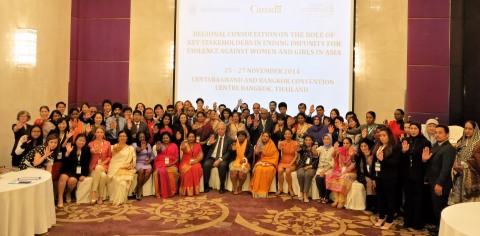Regional Consultation on the Role of Key Stakeholders in Ending Impunity for Violence against Women and Girls in Asia
Event description

Violence against women and girls (VAWG) is a grave violation of human rights, affecting around one in three women in her lifetime . Its impact ranges from immediate to long-term multiple physical, sexual and mental consequences for women and girls, including death. It negatively affects women’s general well-being and prevents women from fully participating in society. Violence not only has negative consequences for women but also their families, the community and society at large. It has tremendous costs, from greater health care and legal expenses and losses in productivity, impacting national budgets and overall development. Cutting across all distinctions of geography, class or ethnicity, VAWG is pervasive throughout the world and firmly grounded in the subordinated status of women and girls and the pervasive gender-biased mind-sets, norms and practices that contribute to such violations and allow them to continue unchallenged.
With the support of the Government of Canada through the Departments of Foreign Affairs, Trade and Development (DFATD) and Commonwealth Secretariat – UN Women will be organizing a regional consultation on the role of key stakholders in ending impunity for VAWG in ASia. The regional consultation will comprise of presentations and focused discussions that will lead into working groups for the identification of key policy and advocacy strategies and concrete priority actions for strenthening jurisprudence of equality on VAWG.
Objectives
- Locate VAWG in the context of international, regional and national human rights law, normative frameworks such as CEDAW and redress mechanisms;
- Facilitate cross-country learning, dialogue and networking among key stakeholders addressing women’s rights and VAWG, including sexual violence, and disseminate new and relevant evidence and information, including case law research, reports from relevant expert group meetings and judicial fora, and sexual violence attrition study findings;
- Highlight the need for enhanced policy and advocacy focus to VAWG and identify common regional issues, priorities and strategies in this area;
- Enable the judiciary, investigators, prosecutors, lawyers, Ombudsperson and NHRIs to share views and good practices with regard to ending impunity for VAWG in the region;
- Develop a regional strategy with multi-stakeholder cooperation to improve access to justice, for example through comprehensive response protocols; and
- Outline a framework for a Judicial Resource Book / Judicial Bench-book on strengthening jurisprudence on violence against women which will assist the judiciary and other relevant stakeholders in advancing jurisprudence on violence against women in the region.
Expected Results
- Increased knowledge among participants on the causes and consequences of impunity for cases of VAWG, especially sexual violence, and improved capacity for how attrition within the criminal justice system can be reduced;
- Sharing of judicial and quasi-judicial experiences of countries within the region, and the role of the judiciary with a view to contributing to strengthened jurisprudence of equality on VAWG;
- Enhanced understanding on how to strengthen collaboration and coordination between key stakeholders to support the effective administration of justice, including the role of the Ombudsperson and NHRIs in ending impunity for VAWG, specifically developing a regional action plan through a consensus of participants to strengthen functional cooperation;
- Identification of a common vision and set of recommendations that will assist key stakeholders within the criminal justice system, including investigators, prosecutors, lawyers, judges and Ombudsperson, to contribute more effectively in addressing the identified gaps and challenges in the delivery of justice in cases of VAWG; and
- Inputs provided for the development of a Judicial Resource Guide and Judicial Bench-book for strengthening jurisprudence on addressing VAW for the Asia region.
Related Documents
- Concept Note
- Provisional Agenda
- Speech: H.E. Mr. Philip Calvert, Ambassador
- Speech: Roberta Clarke, Regional Director UN Women Asia and the Pacific
Supported by:![]()